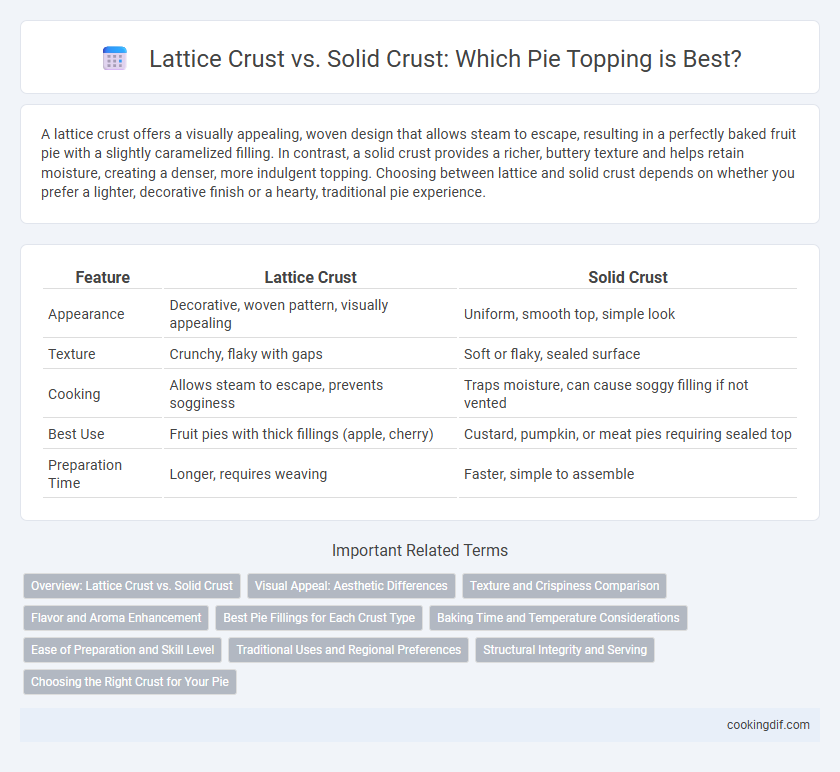A lattice crust offers a visually appealing, woven design that allows steam to escape, resulting in a perfectly baked fruit pie with a slightly caramelized filling. In contrast, a solid crust provides a richer, buttery texture and helps retain moisture, creating a denser, more indulgent topping. Choosing between lattice and solid crust depends on whether you prefer a lighter, decorative finish or a hearty, traditional pie experience.
Table of Comparison
| Feature | Lattice Crust | Solid Crust |
|---|---|---|
| Appearance | Decorative, woven pattern, visually appealing | Uniform, smooth top, simple look |
| Texture | Crunchy, flaky with gaps | Soft or flaky, sealed surface |
| Cooking | Allows steam to escape, prevents sogginess | Traps moisture, can cause soggy filling if not vented |
| Best Use | Fruit pies with thick fillings (apple, cherry) | Custard, pumpkin, or meat pies requiring sealed top |
| Preparation Time | Longer, requires weaving | Faster, simple to assemble |
Overview: Lattice Crust vs. Solid Crust
Lattice crusts create a visually appealing, woven pattern that allows steam to escape, resulting in a flakier texture and more evenly baked filling. Solid crusts provide a protective, sealed layer that traps moisture, producing a richer, juicier pie interior but may require venting to prevent sogginess. Both crust types influence baking time, texture, and presentation, catering to different flavor and aesthetic preferences.
Visual Appeal: Aesthetic Differences
Lattice crusts create an intricate, woven pattern that adds a rustic, artisanal charm to pies, enhancing their visual appeal with visible fruit filling peeking through. Solid crusts offer a smooth, uniform top that provides a classic, polished look, often allowing for decorative cutouts or designs to improve aesthetics. The choice between lattice and solid crust impacts the pie's overall presentation, balancing between showcasing the filling and offering a sleek, elegant appearance.
Texture and Crispiness Comparison
Lattice crusts provide a lighter, airier texture with increased crispiness due to exposed edges and gaps that allow steam to escape during baking. Solid crusts offer a denser, more uniform texture with a chewier bite, as their continuous surface retains moisture and traps steam. The lattice structure creates a balance of crunch and flakiness, whereas solid crusts emphasize robustness and softness under toppings.
Flavor and Aroma Enhancement
Lattice crusts allow more steam to escape during baking, intensifying the pie filling's flavor and releasing a richer, fruit-forward aroma. Solid crusts trap moisture and vapors, resulting in a juicier filling with a subtler, baked-dough aroma. The interplay between crust design and aroma compounds significantly influences the overall sensory experience of the pie.
Best Pie Fillings for Each Crust Type
Lattice crusts work best with fruit fillings like apple, cherry, and blueberry, allowing steam to escape and showcasing vibrant colors while maintaining a crisp texture. Solid crusts complement dense fillings such as pumpkin, pecan, and custard, trapping moisture and enhancing creamy or rich consistency. Choosing the appropriate crust type elevates the overall pie experience by balancing filling texture and flavor with structural integrity.
Baking Time and Temperature Considerations
Lattice crusts typically require a slightly shorter baking time at a moderate temperature, around 375degF (190degC), to prevent over-browning of the exposed fruit filling while ensuring the crust becomes crisp and golden. Solid crusts generally benefit from a longer bake at a consistent 400degF (204degC) to properly cook the denser dough and seal in moisture, avoiding sogginess beneath the crust. Monitoring oven temperature and adjusting baking duration based on crust thickness and fruit moisture content helps achieve an evenly baked pie with a perfect texture.
Ease of Preparation and Skill Level
Lattice crusts require more time and skill to weave and position the dough strips precisely, making them ideal for experienced bakers seeking a decorative finish. Solid crusts offer a simpler, quicker preparation, suitable for beginners or those preferring a straightforward pie topping. Both crust types benefit from proper chilling and handling to prevent shrinking and ensure even baking.
Traditional Uses and Regional Preferences
Lattice crusts are traditionally favored in American fruit pies, especially in regions like the Northeast and Midwest, as they allow steam to escape and showcase the vibrant fillings such as cherry or apple. Solid crusts are common in British and French pie recipes, like steak and kidney or chicken pot pie, providing a rich, buttery barrier that seals in moisture and flavor. Regional preferences often dictate crust choice based on local ingredients and customary baking practices, influencing texture and presentation in classic pie dishes.
Structural Integrity and Serving
Lattice crusts enhance structural integrity by allowing steam to escape during baking, preventing sogginess and maintaining a crisp texture for the topping. Solid crusts provide a sturdy, uniform barrier that supports heavier fillings and offers a clean, cohesive appearance when serving. For easy portioning and presentation, lattice crusts create visually appealing slices, while solid crusts deliver a traditional, firm slice that holds toppings intact.
Choosing the Right Crust for Your Pie
Lattice crusts provide an attractive, golden-brown finish that allows steam to escape, resulting in a perfectly baked filling with balanced moisture. Solid crusts offer a sturdier, richer flavor seal that locks in juices, making them ideal for fruit pies that benefit from a fully enclosed environment. Selecting between lattice and solid crusts depends on the pie's filling type and desired texture, where lattice enhances visual appeal and crispness while solid ensures a tender, moist interior.
Lattice crust vs Solid crust for topping Infographic

 cookingdif.com
cookingdif.com